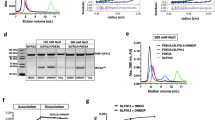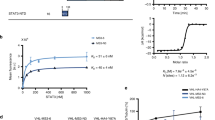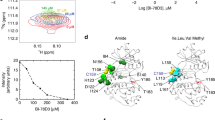Abstract
Protein–protein interactions play critical regulatory roles in mediating signal transduction. Previous studies have identified an unconventional, small-molecule, Src signal transduction inhibitor, UCS15A. UCS15A differed from conventional Src-inhibitors in that it did not alter the levels or the tyrosine kinase activity of Src. Our studies suggested that UCS15A exerted its Src-inhibitory effects by a novel mechanism that involved the disruption of protein–protein interactions mediated by Src. In the present study we have examined the ability of UCS15A to disrupt the interaction of Src–SH3 with Sam68, both in vivo and in vitro. This ability of UCS15A was not restricted to Src–SH3 mediated protein–protein interactions, since the drug was capable of disrupting the in vivo interactions of Sam68 with other SH3 domain containing proteins such as Grb2 and PLCγ. In addition, UCS15A was capable of disrupting other typical SH3-mediated protein–protein interactions such as Grb2–Sos1, cortactin–ZO1, as well as atypical SH3-mediated protein–protein interactions such as Grb2–Gab1. However, UCS15A was unable to disrupt the non-SH3-mediated protein–protein interactions of β-catenin, with E-cadherin and α-catenin. In addition, UCS15A had no effect on the SH2-mediated interaction between Grb2 and activated Epidermal Growth Factor receptor. Thus, the ability of UCS15A, to disrupt protein–protein interactions appeared to be restricted to SH3-mediated protein–protein interactions. In this regard, UCS15A represents the first example of a non-peptide, small molecule agent capable of disrupting SH3-mediated protein–protein interactions. In vitro analyses suggested that UCS15A did not bind to the SH3 domain itself but rather may interact directly with the target proline-rich domains.
This is a preview of subscription content, access via your institution
Access options
Subscribe to this journal
Receive 50 print issues and online access
$259.00 per year
only $5.18 per issue
Buy this article
- Purchase on Springer Link
- Instant access to full article PDF
Prices may be subject to local taxes which are calculated during checkout









Similar content being viewed by others
References
Andreotti AH, Bunnell SC, Feng S, Berg LJ, Schreiber SL . 1997 Nature 385: 93–97
Bar-Sagi D, Rotin D, Batzer A, Mandiyan V, Schlessinger J . 1993 Cell 74: 83–91
Birge R, Knudsen B, Besser D, Hanafusa H . 1996 Genes to Cells 1: 595–613
Cicchetti P, Mayer B, Thiel G, Baltimore D . 1992 Science 257: 803–806
Cohen GB, Ren R, Baltimore D . 1995 Cell 80: 237–248
Combs A, Kapoor T, Feng S, Chen J, Daude-Snow L, Schreiber S . 1996 J. Am. Chem. Soc. 118: 287–288
Dalgarno D, Botfield M, Rickles R . 1997 Biopoly. 43: 383–400
Feng S, Kasahara C, Rickles R, Schreiber S . 1995 Proc. Natl. Acad. Sci. 92: 12408–12415
Finan P, Hall A, Kellie S . 1996 FEBS. L. 389: 141–144
Franz WM, Berger P, Wang JY . 1989 EMBO J. 8: 137–147
Fumagalli S, Totty N, Hsuan J, Courtneidge S . 1994 Nature 368: 871–874
Fusaki N, Iwanatsu A, Iwashima M, Fujisawa J . 1997 J. Biol. Chem. 272: 6214–6219
Gale N, Kaplan S, Lowenstein E, Schlessinger J, Sagi D . 1993 Nature 363: 88–90
Gorina S, Pavletich NP . 1996 Science 274: 1001–1005
Hanke JH, Gardner JP, Dow RL, Changelian PS, Brisette WH, Weringer EJ, Pollok BA, Connelley PA . 1996 J. Biol. Chem. 271: 695–701
Huber A, Weis W . 2001 Cell 105: 391–402
Hulsken J, Birchmeier W, Behrens J . 1994 J. Cell Biol. 127: 2061–2069
Hunter T . 2000 Cell 100: 113–127
Jabado N, Jauliac S, Pallier A, Bernard F, Fischer A, Hivroz X . 1998 J. Immunol. 161: 2798–2803
Jackson P, Baltimore D . 1989 EMBO J. 8: 449–456
Ji X, Zhang P, Armstrong RN, Gilliland GL . 1992 Biochem. 31: 10169–10184
Kato M, Miyazawa K, Kitamura N . 2000 J. Biol. Chem. 275: 37481–37487
Katsube T, Takahisa M, Hashimoto N, Kobayashi M, Togashi S . 1998 J. Biol. Chem. 273: 29672–29677
Kay BK, Williamson MP, Sudol M . 2000 FASEB J. 14: 231–241
Koch C, Anderson D, Moran M, Ellis C, Pawson T . 1991 Science 252: 668–674
Ladbury J, Arold S . 2000 Chem. Biol. 7: R3–R8
Lewitzky M, Kardinal C, Gehring NH, Schmidt EK, Konkol B, Eulitz M, Birchmeier W, Schaeper U, Feller SM . 2001 Oncogene 20: 1052–1062
Li N, Batzer A, Daly R, Yajnik V, Skolnik E, Chardin P, Sagi D, Margolis B, Schlessinger J . 1993 Nature 363: 85–88
Lowenstein E, Daly R, Batzer A, Li W, Margolis B, Lammers R, Ullirich A, Schlessinger J . 1992 Cell 70: 431–442
Mano H . 1999 Cytokine Growth Factor Rev. 10: 267–280
Manser E, Loo TH, Koh CG, Zhao ZS, Chen XQ, Tan L, Tan I, Leung T, Lim L . 1998 Mol. Cell 1: 183–192
Mayer B, Baltimore D . 1993 Trends Cell Biol. 3: 8–13
Mayer BJ . 2001 J. Cell. Sci. 114: 1253–1263
Mayer BJ, Baltimore D . 1994 Mol. Cell Biol. 14: 2883–2894
Mongiovi AM, Romano PR, Panni S, Mendoza M, Wong WT, Musacchio A, Cesareni G, Paolo Di Fiore P . 1999 EMBO J. 18: 5300–5309
Nguyen J, Porter M, Amoui M, Miller W, Zuckermann R, Lim W . 2000 Chem. Biol. 7: 463–473
Nguyen JT, Lim WA . 1997 Nature 4: 256–260
Nishida M, Nagata K, Hachimori Y, Horiuchi M, Ogura K, Mandiyan V, Schlessinger J, Inagaki F . 2001 EMBO J. 20: 2995–3007
Pai L, Kirkpatrick C, Blanton J, Oda H, Takeichi M, Peifer M . 1996 J. Biol. Chem. 271: 32411–32420
Parker MW, Bello ML, Federici G . 1990 J. Mol. Biol. 213: 221–222
Pawson T . 1995 Nature 373: 573–580
Pawson T, Schlessinger J . 1993 Curr. Biol. 3: 434–442
Pillay I, Nakano H, Sharma SV . 1996 Cell Growth Differ. 7: 1487–1499
Ponting CP, Aravind L, Schultz J, Bork P, Koonin EV . 1999 J. Mol. Biol. 289: 729–745
Reinemer P, Dirr HW, Ladenstein R, Schaffer J, Gallay O, Huber R . 1991 EMBO J. 10: 1997–2005
Ren R, Mayer BJ, Cicchetti P, Baltimore D . 1993 Science 259: 1157–1161
Richard S, Yu DY, Blumer KJ, Hausladen D, Olszowy MW, Connelly PA, Shaw AS . 1995 Mol. Cell. Biol. 15: 186–197
Rickles RJ, Zoller MJ . 1994 EMBO J. 13: 5598–5604
Rozakis-Adcock M, Fernley R, Wade J, Pawson T, Bowtell D . 1993 Nature 363: 83–85
Rubin GM, Yandell MD, Wortman JR, Gabor Miklos GL, Nelson CR, Hariharan IK, Fortini ME, Li PW, Apweiler R, Fleischmann W, Cherry JM, Henikoff S, Skupski MP, Misra S, Ashburner M, Birney E, Boguski MS, Brody T, Brokstein P, Celniker SE, Chervitz SA, Coates D, Cravchik A, Gabrielian A, Galle RF, Gelbart WM, George RA, Goldstein LS, Gong F, Guan P, Harris NL, Hay BA, Hoskins RA, Li J, Li Z, Hynes RO, Jones SJ, Kuehl PM, Lemaitre B, Littleton JT, Morrison DK, Mungall C, O'Farrell PH, Pickeral OK, Shue C, Vosshall LB, Zhang J, Zhao Q, Zheng XH, Lewis S . 2000 Science 287: 2204–2215
Schaeper U, Gehring NH, Fuchs KP, Sachs M, Kempkes B, Birchmeier W . 2000 J. Cell Biol. 149: 1419–1432
Schlessinger J . 1994 Curr. Opin. Genet. Dev. 4: 25–30
Schwartzberg PL . 1998 Oncogene 17: 1463–1468
Seidel-Dugan C, Meyer BE, Thomas SM, Brugge JS . 1992 Mol. Cell. Biol. 12: 1835–1845
Sharma SV, Oneyama C, Yamashita Y, Nakano H, Sugawara K, Hamada M, Kosaka N, Tamaoki T . 2001 Oncogene 20: 2068–2079
Shen Z, Batzer A, Koehler JA, Polakis PP, Schlessinger J, Lydon NB, Moran MF . 1999 Oncogene 18: 4647–4653
Smithgall T . 1995 J. Pharmacol Toxicol Methods 34: 125–132
Sparks A, Quilliam L, Thorn J, Der C, Kay B . 1994 J. Biol. Chem. 269: 23853–23856
Sparks AB, Rider JE, Hoffman NG, Fowlkes DM, Quilliam LA, Kay BK . 1996 Proc. Natl. Acad. Sci. USA 93: 1540–1544
Sudol M . 1998 Oncogene 17: 1469–1474
Summy J, Guappone A, Sudol M, Flynn D . 2000 Oncogene 19: 155–160
Taylor S, Anafi M, Pawson T, Shalloway D . 1995 J. Biol. Chem. 270: 10120–10124
Taylor SJ, Shalloway D . 1994 Nature 368: 867–871
Tsukita S, Furuse M, Itoh M . 1999 Curr. Opin. Cell Biol. 11: 628–633
Yamashita Y, Miyazato A, Ohya K, Ikeda U, Shimada K, Miura Y, Ozawa K, Mano H . 1996 Jpn. J. Cancer Res. 87: 1106–1110
Yu H, Chen J, Feng S, Dalgarno D, Brauer A, Schreiber S . 1994 Cell 76: 933–945
Zhu T, Goh ELK, LeRoith D, Lobie PE . 1998 J. Biol. Chem. 273: 33864–33875
Acknowledgements
We thank Dr Margaret Quinlan for carefully editing the manuscript and for her valuable comments.
Author information
Authors and Affiliations
Corresponding author
Rights and permissions
About this article
Cite this article
Oneyama, C., Nakano, H. & Sharma, S. UCS15A, a novel small molecule, SH3 domain-mediated protein–protein interaction blocking drug. Oncogene 21, 2037–2050 (2002). https://doi.org/10.1038/sj.onc.1205271
Received:
Revised:
Accepted:
Published:
Issue Date:
DOI: https://doi.org/10.1038/sj.onc.1205271
Keywords
This article is cited by
-
Sam68 is a druggable vulnerability point in cancer stem cells
Cancer and Metastasis Reviews (2023)
-
PEPD is a pivotal regulator of p53 tumor suppressor
Nature Communications (2017)
-
tr-kit promotes the formation of a multimolecular complex composed by Fyn, PLCγ1 and Sam68
Oncogene (2003)



